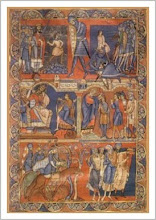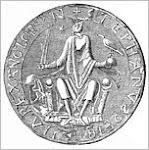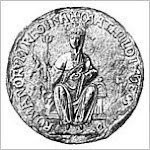• Henry I - Edith of Scotland (Matilda) and Adelica of Louvain
Henry I, Beauclerc
Reign: 1100-1135
Birth: c.1067-68, Selby, Yorkshire, England
Death: 1 December 1135, Saint Denis en Lyons
Burial: Reading Abbey
Father: William I the Conqueror, King of England
Mother: Matilda of Flanders
Marriage: (1) 1100, Westminster Abbey, London - Edith (Matilda) of Scotland
Children:
infant, possibly named Richard
William, Duke of Normandy (died 1120)
Matilda, The Empress
Marriage: (2) 1122, Westminster Abbey, London - Adelica of Louvain
No children
Other Notable Children:
Robert, Earl of Gloucester - illegitimate son to a Welsh gentlewoman
Sybil
NOTES: Deposed his brother Robert in 1106 in the Battle of Tinchebrai and became both Duke of Normandy and King of England as his father had been. His addition to the administrative system was the Court of the Exchequer, for the better collecting of taxes. The chief administrator of the new court was the Justiciar, who became the chief minister of the realm. During Henry's reign this was Roger, Bishop of Salisbury.
• Warfare between Henry I and Robert Curthose, according to Wace: Warfare between Henry I and Robert Curthose
Henry lost his son and heir, William, in the White Ship disaster on 25th November 1120. With no children forthcoming from his second marriage to Adelica of Louvain, despite the fact that he had fathered numerous illegitimate children, Henry took the unprecedented step of nominating his only surviving legitimate child, daughter Matilda, as his heir. In 1127/8 he married Matilda to Geoffrey of Anjou in order to secure peace between England, Normandy, and Anjou. However, it was an unpopular move amongst the barons and clergy.
The month of December marks the death of King Henry I in 1135, supposedly to a 'surfeit of lampreys'. His death also marks the beginnings of events that would lead to nearly 20 years of civil war for England. On hearing the news of his uncle's death Stephen of Blois, Count of Mortain and Boulogne, Henry's favourite nephew, promptly sailed to England and convinced the clergy to crown him King of England. It is said that Stephen's clever brother Henry, Bishop of Winchester and later Papal Legate, also played a large part in the negotiations of the usurpation of the crown. Matilda and Geoffrey, bided their time and firstly secured Anjou and then Normandy, but finally in 1139 with her half brother Robert of Gloucester as her main supporter, she invaded England in an attempt to regain her inheritance.
Thus began the years of 'The Anarchy' between the supporters of Stephen and Matilda, which only ended in 1153 with the Treaty of Wallingford (also called Treaty of Westminster) when Stephen agreed to have Matilda's son Henry as his heir.
Edith of Scotland (Matilda)
Born: c.1080 Dunfermline, Scotland
Died: 1 May 1118, Westminster Palace
Burial: Westminster Abbey
Father: Malcolm III of Scotland
Mother: Saint Margaret of Scotland
Marriage: Henry I
NOTES: Edith of Scotland (Matilda) - first wife and Queen consort of Henry I - and through her mother descended from Edmund Ironside and thus Alfred the Great. Her name was changed from Edith to Matilda after her marriage to Henry.
When Matilda was about six years old she and her sister Mary were sent to Romsey where their aunt Cristina was Abbess. Matilda and Henry seem to have known each another for some time before their marriage, but because she had spent so much of her life in a nunnery there was some controversy over whether or not she had been veiled as a nun, so Henry sought permission for the marriage from Archbishop Anselm of Canterbury. Anselm called a council of bishops of the realm, at which Matilda testified that she had never taken holy vows. The council gave their permission for the marriage, which took place in November 1100 at Westminster Abbey.
As Queen, Matilda accompanied her husband in his travels and served in a vice regal capacity when Henry was away from court. Her court was based in Westminster and was filled with musicians and poets, and she was renowned for her devotion to religion and the poor. She also administered extensive dower properties and was known as a patron of the arts. England and Scotland became politically closer during this marriage, during which time three of her brothers served as kings of Scotland and were unusually friendly to England during this period.
Matilda died on 1 May 1118 at Westminster Palace, so she did not live to see her only son William perish in the White Ship disaster in 1120, and was buried at Westminster Abbey. After her death she was remembered by her subjects as "Matilda the Good Queen" and "Matilda of Blessed Memory".
Adelica of Louvain (Adeliza of Leuven)
Born: c.1103
Died: 23 April 1151, Affligem Abbey, Brabant
Burial: Affligem Abbey, Brabant
Father: Godfrey I of Leuven
Mother: Countess Ida of Namur
Marriage: Henry I
NOTES: Adelica of Louvain - Queen consort of the Kingdom of England from 1122 to 1135, second wife of Henry I - married Henry in February 1122, supposedly chosen due to his desire for a male heir. However, no children were born during this marriage.
Adelica did not play a big part in the public life of the realm during her time as queen consort, but she did her leave a mark as a patron of literature and several works including a bestiary by Philip de Thaon were dedicated to her.
After Henry I died on 1 December 1135 Adelica retired to the monastery of Wilton near Salisbury for a period of time, but before 1139 she married William d'Aubigny, who had been one of Henry's chief advisors. She brought to the marriage a Queen's dowry including the castle of Arundel, and Stephen of England created d'Aubigny Earl of Arundel and Earl of Lincoln. Her husband was a staunch supporter of Stephen during the civil war, but when Empress Matilda landed in England in 1139 Adelica received her as a guest of the former Queen.
In a very ironic twist, this second marriage produced 7 children who survived until adulthood:
Reynor d'Aubigny
Henry d'Aubigny
Alice, Countess of Eu
Olivia d'Aubigny
Agatha d'Aubigny
William d'Aubigny, 2nd Earl of Arundel
Geoffrey d'Aubigny
One of Adelica's brothers, Joscelyn de Louvain, to whom she was very close, came to England and married Agnes de Percy, heiress of the Percy family. His children took their name from their mother's lineage, and their descendants include the medieval Earls of Northumberland. Adelica also became an active patron of the church during her second marriage and gave property to Reading Abbey in honour of her former husband and to several other smaller foundations.
Adelica spent her final years in the abbey of Affligem which she richly rewarded with landed estates and after her death was buried in the abbey church next to her father, Duke Godfrey I of Leuven.
* Footnote: William d'Aubigny, 2nd Earl of Arundel - father to William d'Aubigny, 3rd Earl of Arundel who was one of the twenty five guarantors of the Magna Carta.
• Henry I according to Orderic Vitalis: Henry I
Subscribe to:
Post Comments (Atom)








No comments:
Post a Comment